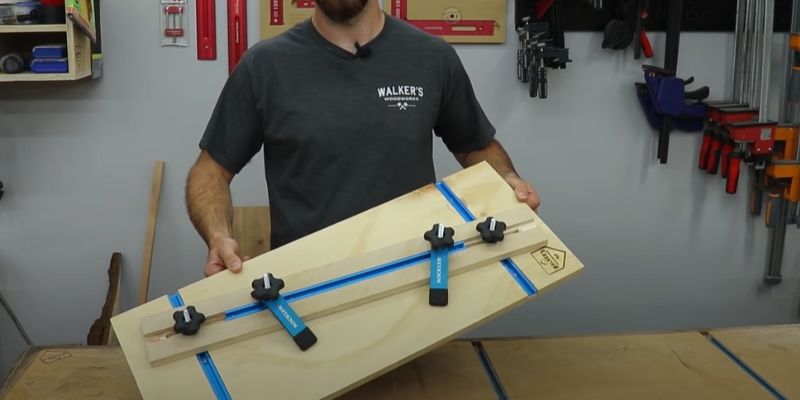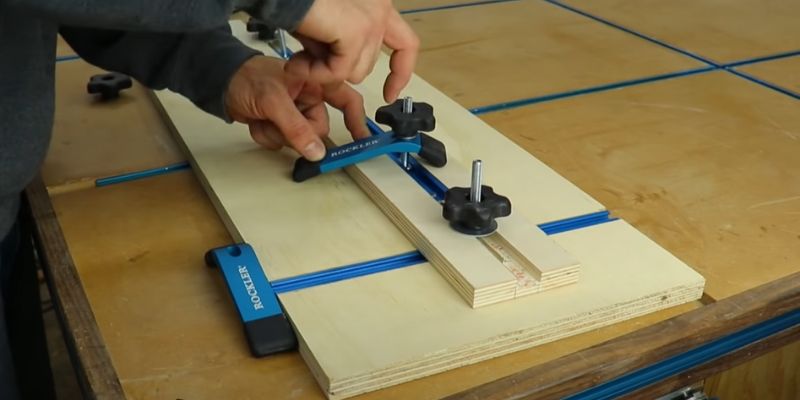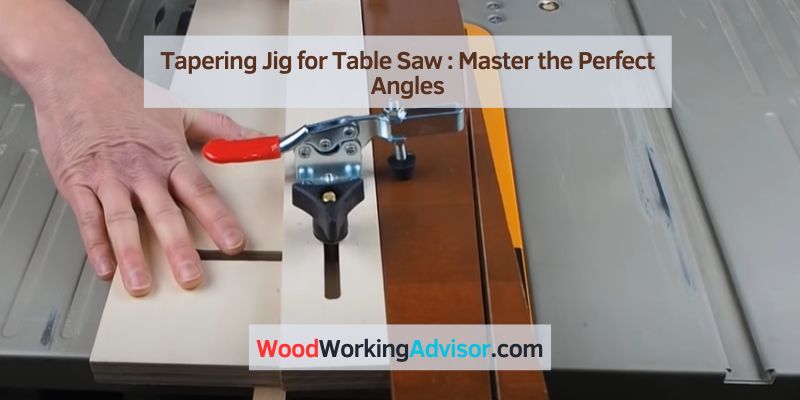A tapering jig for table saw is a precision tool used to make angled cuts on wood or other materials. It provides stability and accuracy, ensuring consistent results in woodworking projects.
The tapering jig enhances safety and control when cutting tapered edges, making it a necessary accessory for any table saw user. Woodworking enthusiasts and professionals alike understand the efficiency and accuracy that a tapering jig can bring to their projects.
This tool is a key component in achieving precise and consistent angled cuts on a table saw. With a tapering jig, woodworkers can confidently create tapered legs, panels, and other intricate designs with ease. Its versatility and precision make it an essential accessory for anyone looking to improve their woodworking skills. We will explore the benefits and features of a tapering jig, as well as provide tips on how to use it effectively to enhance your woodworking projects.
Tapering Jig For Table Saw : Craft Precision Angles
When it comes to woodworking, precision is key. Crafting precise angles is essential for creating high-quality, professional-looking woodwork. One indispensable tool for achieving precision in tapering wood pieces is the tapering jig for table saw. This tool allows woodworkers to craft intricate and accurate tapered cuts, enhancing the visual appeal and structural integrity of their projects. In this article, we’ll delve into the tapering jig for table saw, exploring its value in woodcraft and the crucial role it plays in crafting precision angles.
Understanding The Value Of Precise Angles In Woodcraft
In woodworking, precise angles are crucial for creating aesthetically pleasing and structurally sound wood pieces. Whether it’s for crafting furniture, trim work, or decorative elements, achieving accurate tapers contributes to the overall quality of the finished product. Precision angles not only enhance visual appeal but also ensure proper fit and stability when joining wood components.
Anatomy Of A Tapering Jig For Table Saw
The tapering jig for table saw consists of several key components that enable woodworkers to achieve accurate tapers. These include a sturdy base, a guide fence, and an adjustable mechanism for controlling the angle of the taper. The guide fence provides stability and ensures that the wood piece maintains consistent contact with the saw blade throughout the cutting process. Understanding the anatomy of this essential tool is paramount for utilizing it effectively in woodcraft.
Aligning The Jig For Optimal Performance
To maximize the performance of a tapering jig, proper alignment is essential. Ensuring that the jig is securely positioned and the wood piece is firmly secured guarantees precise and safe taper cuts. Additionally, understanding how to adjust the angle settings on the jig is critical for achieving the desired taper width and angle. Proper alignment and adjustment are crucial for harnessing the full potential of a tapering jig for table saw.

Choosing The Right Tapering Jig
A tapering jig is an essential tool for creating beautiful and precise tapered cuts on a table saw. When selecting the right tapering jig for your woodworking projects, there are several important factors to consider. From adjustability and build quality to the compatibility with different table saw models, making an informed decision can significantly enhance the accuracy and efficiency of your tapering tasks.
Factors To Consider: Adjustability, Material, And Design
Adjustability: Look for a tapering jig that offers a wide range of adjustability to accommodate various taper angles. The ability to make micro-adjustments can help achieve precise and custom taper cuts, making it a versatile tool for different woodworking projects.
Material: The material of the tapering jig should be durable and sturdy enough to withstand the pressures of woodworking tasks. Consider jigs made of high-quality metals or durable composite materials for longevity and reliability.
Design: Opt for a tapering jig with a well-thought-out design that ensures stability and ease of use. Features such as ergonomic handles, clear measurement markings, and secure clamping mechanisms can contribute to a seamless tapering experience.
Compatibility With Different Table Saw Models
Ensure that the tapering jig is compatible with your specific table saw model. Some jigs may require additional accessories or modifications to be compatible with certain saws, so researching compatibility beforehand can save time and frustration.
The Impact Of Build Quality On Angle Accuracy
Angle Accuracy: The build quality of the tapering jig directly influences the accuracy of taper cuts. Look for jigs constructed with precision and attention to detail to ensure consistent and reliable angle adjustments. A well-built tapering jig can make all the difference in achieving the desired taper angle with minimal margin of error.
Setting Up Your Tapering Jig
Setting up your tapering jig correctly is crucial to ensuring precision and safety when using it with your table saw. Whether you are a seasoned woodworker or just getting into the craft, understanding how to properly assemble and adjust the tapering jig is essential for successful woodworking projects. In this guide, we’ll walk through the step-by-step assembly process, how to adjust the jig for various taper angles, and important safety considerations to keep in mind during setup and use.
Step-by-step Assembly Guide
- Start by gathering all the components of your tapering jig, including the base, guide fences, and locking mechanisms.
- Attach the guide fences to the base using the provided screws, ensuring they are securely fastened for stability.
- Mount the jig onto your table saw’s miter gauge slots, making sure it is aligned parallel to the blade for accurate cuts.
- Double-check all connections and adjustments to confirm that the jig is firmly in place and ready for use.
Adjusting The Jig For Various Taper Angles
To adjust the tapering jig for different angles, start by loosening the locking mechanisms to allow flexibility in positioning. Use a protractor or angle gauge to set the desired angle, then tighten the locks to secure the jig in place. Always verify the angle and alignment before making cuts to ensure precision and accuracy in your woodworking projects.
Ensuring Safety During Setup And Use
- Before operating the table saw with the tapering jig, ensure that all safety guards and protective equipment are in place.
- Clear the work area of any obstructions or distractions that could interfere with the operation of the jig and table saw.
- Double-check the alignment and stability of the jig before making any cuts to prevent potential accidents or errors.
- Always follow manufacturer’s guidelines and recommendations for the safe use of the tapering jig with your specific table saw model.
Mastering Angle Cuts With Tapering Jig
For woodworkers and DIY enthusiasts, the ability to make precise and consistent angle cuts is often a crucial skill. Whether it’s for crafting furniture, constructing frames, or adding an elegant touch to a project, mastering angle cuts can greatly enhance the quality of your woodworking. With a Tapering Jig for Table Saw, you can achieve this precision and consistency, opening up a world of possibilities for your woodworking projects.
Techniques For Consistent Taper Cuts
When it comes to achieving consistent taper cuts using a tapering jig, the following techniques can prove invaluable:
- Utilize a push block to ensure the workpiece remains securely in place as it moves through the saw blade.
- Measure and mark the precise taper width on the workpiece to accurately guide the cuts.
- Use a featherboard to maintain steady pressure against the fence, keeping the workpiece in position throughout the cutting process.
Adjusting For Compound And Complex Angles
While tapering jigs are ideal for creating simple taper cuts, they can also be adjusted to accommodate compound and complex angles. To do this, consider the following adjustments:
- Angle the tapering jig to the desired angle, ensuring the workpiece is securely clamped in place for stability.
- Make gradual adjustments to the angle, testing your cuts on scrap pieces until the desired compound or complex taper angle is achieved.
Tips For Avoiding Common Tapering Mistakes
To ensure optimal results when using a tapering jig, consider the following tips to avoid common tapering mistakes:
- Double-check the positioning and alignment of the tapering jig and workpiece before making any cuts.
- Use a sharp saw blade to ensure clean and precise cuts, reducing the likelihood of tear-out along the tapered edges.
- Regularly inspect and maintain the tapering jig to ensure it remains in perfect working condition for accurate and reliable cuts.

Advanced Tapering Jig Applications
This section will explore the advanced applications of a tapering jig for table saw, demonstrating its versatility and adaptability in various woodworking projects. With the ability to create precise and complex angles, the tapering jig opens up a world of creative possibilities for woodworkers of all skill levels.
Creative Projects Using Tapering Jig Angles
When it comes to employing a tapering jig for advanced woodworking projects, there are numerous creative applications to explore. Some innovative projects that can be achieved by leveraging the angles and precision of a tapering jig include:
- Creating intricate chair legs with unique tapering angles
- Fashioning custom stair treads with specialized tapering dimensions
- Designing artistic table legs with dynamic tapering profiles
Adapting The Jig For Non-standard Woodworking Tasks
Aside from its traditional tapering applications, the tapering jig can be adapted for non-standard woodworking tasks with ingenuity and modification. Some non-standard tasks that can be accomplished by adapting the tapering jig include:
- Routing dadoes and grooves using the tapering jig as a guiding tool
- Creating custom joints and miters by combining the tapering jig with other woodworking tools
- Utilizing the tapering jig as a guide for creating unique curved cuts and contours
Maintenance And Care For A Long-lasting Jig
Ensuring the longevity and functionality of the tapering jig requires proper maintenance and care. To maintain a long-lasting jig, woodworkers should:
- Clean the jig regularly to prevent sawdust buildup and maintain smooth operation
- Inspect and tighten any loose components to guarantee precision and safety
- Store the jig in a dry and secure location to protect it from damage and corrosion
Frequently Asked Questions For Tapering Jig For Table Saw
What Is A Tapering Jig For A Table Saw Used For?
A tapering jig for a table saw is used to make consistent angled cuts on workpieces, such as creating tapered table legs or other angular cuts. It ensures precise and repeatable results, making it an essential accessory for woodworking projects.
How To Use A Tapering Jig With A Table Saw?
To use a tapering jig with a table saw, secure the workpiece to the jig, adjust the jig to the desired angle, and then guide the jig and workpiece through the table saw’s blade. Always follow safety precautions and refer to the jig’s manual for specific instructions.
What Are The Benefits Of Using A Tapering Jig For Table Saw?
Using a tapering jig for a table saw allows woodworkers to create custom, precision cuts with ease. It simplifies the process of making tapered cuts, improves efficiency, and enhances the overall accuracy and quality of woodworking projects.
Can A Homemade Tapering Jig Be Used With A Table Saw?
Yes, a homemade tapering jig can be used with a table saw, provided it is well-constructed and securely holds the workpiece at the desired angle. However, it’s important to ensure that the jig is safe, accurate, and compatible with the table saw being used.
Conclusion
To sum up, a tapering jig for the table saw is an indispensable tool for creating precise and accurate angled cuts. With its versatility and ease of use, it empowers woodworkers to pursue a wide range of projects with confidence.
Incorporating a tapering jig into your woodworking toolkit can elevate the quality and precision of your craft.


